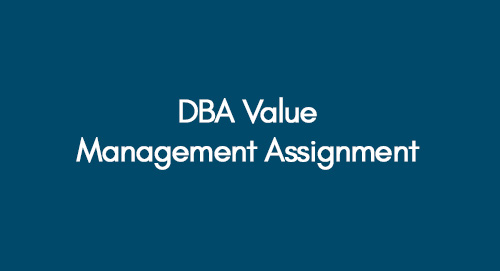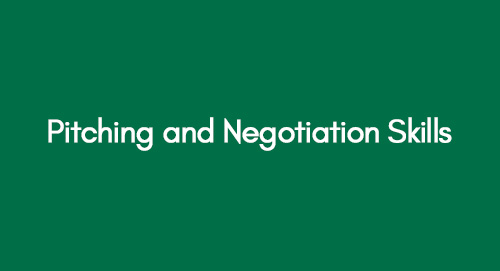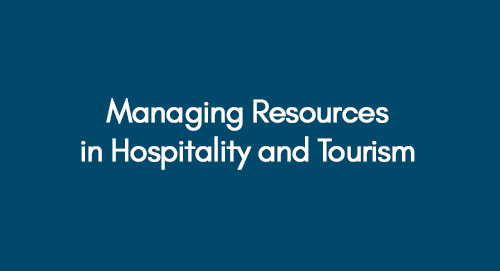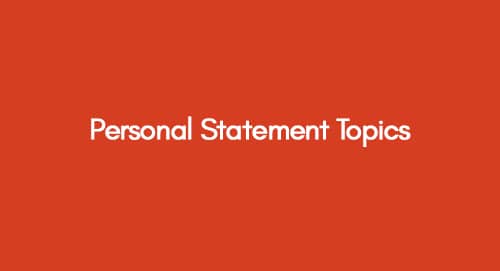
DBA Value Management Assignment
January 13, 2021
Pitching and Negotiation Skills
January 14, 2021Introduction
Every organisation makes use of various resources such as equipment, furniture, money, human resource etc. All organisations necessitate that all the requisite resources are available for its business while making sure that those resources are not in excess otherwise they will be wasted. A process by which a company manages and deploys its various recourses in the optimized and most efficient manner is defined as resource management (Enz, 2009). It is worth noting that word ‘resources’ is not limited to the financial assets of an organisation only but it is a wider concept (Pantelidis, 2013). Some of those main resources include; human resources, financial resources, IT resources, inventory, and production resources (Stipanuk, 2006).
Resource management in the hospitality industry enables hospitality businesses to ensure that enough physical resources are timely available, such as supplies or labour, without excessive surplus (Mullins, 2001). Moreover, it also covers the effective human resource management which will prevent employees’ idle time and keep them productive (Gregoire & Spears, 2007). Research is evident that the effectiveness of an organisation could be determined on the basis of the quality of its human resource and how efficiently its other resources are used and managed (Mullins, 2001).
In this regards, in this essay the two following concepts regarding resource management will be analyzed; a) location, facility design and service delivery system, and b) capacity planning and revenue management. Based on existing literature, the business operations of Marriott International will be critically appraised from effective resource management and business management perspective. Marriott International is a well-known hospitality based company, comprises of a diverse group of hotels and lodging businesses. It is an American based company having over four thousand properties in more than eighty countries across the world. (Marriott.com, 2015)
-
A Critical Appraisal of the Location, Facility Design and Service Delivery System of Marriott International
Marriott International is a luxury chain of hotels. It is one of the renowned hotel brands in the world. It owns various resorts, lodges and hotel businesses such as Four Seasons, Ritz-Carlton, and Park Hyatt. It has 16 hotels brands and it is present in more than 26 countries worldwide, having 4,000 hotels internationally. Marriott International collectively offers around seven hundred thousand rooms in all of its hotels and lodges. In addition, the development of around two hundred thousand additional rooms is in progress. This makes Marriott the largest hotel company in the world. Its hotels are in major cities in more than 80 countries which include; America, Canada, Brazil, UK, China, India, Pakistan, Saudi Arabia, UAE, Turkey, Italy, Malaysia, Thailand etc. This suggests that Marriott tends to find key locations for its hotels. (Marriott.com, 2015)
Location plays a significant role in attracting customer (Konz, 1985). Marriott finds key locations for its hotels for instance major cities and areas in the cities which help it in developing luxury brand image and attracting the desired customer segment (Marriott.com, 2015). A research study based on 200,000 hotel guests found the location of a hotel to be the most important reason for selecting a hotel. (Alonso & Ogle, 2008)
There are various reasons due to which location of a hotel plays a major role in customers’ selection. A study was evident that the location of a hotel is important due to its closeness to sightseeing, business, major highways, airport, shopping centres and theatres and so on (Brotherton, 2003). From travelling perspective location of a hotel can play a major role in the overall enjoyment of travellers.
For instance, if a hotel is located in a well known key location then it can help in preventing time wastage due to traffic and navigation. Moreover, centrally located hotels give more ease of getting around and accessibility in a city and make it easier for visitors to know the area (Pantelidis, 2013). In this regards, Marriott tends to select central and key locations for its hotels, for instance, Marriott Karachi, is located near the city centre and the location is also in close proximity with Government offices such as Minister House and also to the posh areas of Karachi such as Clifton. (Marriott.com, 2015)
Besides, for tourists hotel’s location near major attractions plays an important role in selection as it makes sightseeing easy and will save travelling time and cost. Marriott also addresses this aspect while selecting a location for its hotel and have established hotel in places which have a great tourist attraction. For instance, Marriott Hotels Mecca, Saudi Arabia which is located near the ‘Masjid al-Haram’ the place where billions of Muslims travel annually to perform the pilgrimage.
The literature suggests that facility design is identified as a core factor for developing value addition for the visitors and the operations of a hotel (Stipanuk, 2006). It is evident that guest perception of the quality of a hotel is influenced by its facility design (Countryman, 2001).
Hotel design is identified as an important means to attract guest by creating an attractive atmosphere in public areas like entrance hall. Lobby designing was found to have a significant influence on customer behaviour towards the environment of a hotel (Thapa, 2007). Marriott knows the importance of hotel physical design on its customers, therefore, it keeps on improving its design to improve space utilization and flexibility, address customer’s changing needs, and provides better ambience and environment (Alexander, 2006).
For instance, the breakfast buffet portion in the Marriott Courtyard Aberdeen, Maryland, USA, was remained unused daily for a significant period of time. Therefore to better utilize the space and improve the environment, Marriott redesigned its service model and physical design by transforming the buffet portion into ‘bistros’. Moreover, it has redesigned its lobby and public space environment to provide more flexible space to the customer for work and relax. The new lobbies are provided with Touchscreen TV and laptop friendly stations providing ease and flexibility to the guests. (Robbins, 2011)
Service delivery system is an arrangement of an organisation’s networks and technology by which services are delivered according to the customers’ needs and requirements. Marriott aims at developing its service delivery system based on customers’ needs and requirements while achieving efficiency. It keeps track of and addresses its customers’ feedback and keeps on improving its service delivery system by enhancing designs, environment, layouts and providing facilities such as Touchscreen TV and laptop friendly stations, Wifi etc as per customers’ recommendations. (Robbins, 2011)
-
An Appraisal of the Application of Capacity Planning and Revenue Management of Marriott International
The application of capacity planning and revenue management is aimed to reduce cost and improve efficiency. Capacity planning refers to the process by which the required production capacity based on expected or fluctuation in demand is determined. In the hotel industry, the production capacity may refer to the number of rooms or seats a hotel can offer to its customer (Anderssona, 1995). In this regards capacity planning in the hotel industry would refer to the process by which a hotel can determine the required number of rooms or seats required to meet the demands of its guests. Capacity planning enables an organisation to know its expected demand so that it can identify what amount or number of resources it would require to fulfil the demand. It helps hotels in dealing with fluctuating demand, achieving efficiency by cutting down extra cost on underutilize resources. (Jones, 1999)
It is very important that a hotel knows its production capacity and demand and plan its capacity accordingly to prevent under or overutilization of resources, leading towards inefficiency. In this way, the capacity planning enables a hotel to minimize this discrepancy between production capacities and demand (Enz, 2009). Marriott International performs capacity planning by means of doing floor plans and a capacity chart to identify its room capacity and customer demand (Marriott.com, 2015b). It helps it in achieving efficiency by cutting down extra cost on underutilized resources. There are 14 reservation centres which Marriott operates all over the world to manage its reservation. The reservation system is referred to as MARSHA which Marriott uses for effectively managing its demand and is integrated with its revenue management process. (Marriott.com, n.d.)
The concept of Revenue Management was founded in the 1980s and since then it has been identified as a tool of business for the new and old, small and big and especially continuously expanding airline companies to help them compete with cost-effective competitors (Cross, 1997). It can also improve the availability of the product and price for the maximization of profits. Defining revenue management with 100% accuracy is not possible as one definition as it is a wide concept and may vary with the context of a situation or a project. However, revenue management is a process by which a product’s price and availability are optimized aimed at revenue maximization based on predicted consumer behaviour. (Chase, 2007)
In circumstances in which requirements are restrictive, perhaps a complete definition will be described as objectives and actions of those who practice management of revenue and if it is in an industry of hotels, it means to give rooms that are correct to the correct client on correct time and place as well at a proper price (Chase, 2007). While practising, revenue management merges an approach of differential pricing with capacity planning that is proactive and order booking procedure that is sophisticated in nature to help deal with demand, improve the reliability of deliveries and to recognize added returns from transformations of commands. When this system is applied in the businesses with similar issues such as; businesses with a permanent number of products to be sold, having resources which might get expired and in such markets where customers can bear price and accept it based on segmentation of the market (Cross, 1997). In this regards, Marriott hotels tend to perform customer segmentation and target their offerings according to the customers’ requirements. (Marriott.com, n.d.)
The payback and benefits coming from the management of revenue qualify very easily. When revenue management is discussed at the user level, it makes sure that the returns from business are maximized and the cost of business (operating costs) will surely be covered. At the customer level, management of revenue helps to make the market further competitive consequently making sure of the opportunity of good deals for the customer which means they can buy a service or product at a good price. Revenue management can forecast the micro-level behaviour of consumers (Mullins, 2001). Marriott utilizes the revenue management process from both the perspective aim to reduce operating costs. (Marriott.com, 2015)
CRM which stands for Customer Relationship Management is an approach in which policies of a company are efficient and made on the basis of consumer centrism. Such policies look for reduction of expenses while increasing returns as a result of strengthening the loyalty of consumers. We can also express it as revenue management that is based on consumer’s values. It is a management of revenue because repeated business is ensured from it and therefore it also gives additional information to be used in procedures of forecasting. According to Martens and Hilbert (2011), the capacity control itself and the influence it puts forth should be examined to conclude the best approach either if it is based on the value of customers or based on transactions. It is obvious that any measure through which a hotel company is able to generate repeated business has some economic wisdom.
However, CRM merges additional characteristics of theories which are measured by consumer study with realistic executions of successful customer service and bring together all the useful information in an arrangement which permits enhancement and set up of a system that is determined by consent of consumers. (Gregoire, & Spears, 2007)
Moreover, the apparent advantage for the users of CRM in terms of revenue management is the visitors being pleased by the service all in all which results in recurring business which is expectant. This promotes a constructive status while making sure of the supporter base growing continually. CRM as seen from the consumer’s perspective, everything is positively constructive. Today companies are trying hard to keep good relations with their customers and for this reason, companies may consider their all customer’s preferences.
For the company and CRM, getting accurate and appropriate information is the principal concern as finding suitable models and pointers to forecast values of customers is an obligation for the execution of strategies. With regards to CRM, Marriott revenue management is based on customer-value as it gives high emphasis on identifying, attracting retaining high-value customers. It tends to modify its services based on user feedback and changing needs which are reflected by its marketing strategies. (Marriott.com, 2015; Marriott.com, n.d.)
One more method of revenue management is the business possibility to reduce expenses (Enz, 2009). When numerous revenue pathways which are destined to fail and be lost are reduced, revenue is maximized. If a hotel company offers a service from which it becomes less expensive to book straight from hotel compared to an agent, then it is probable that customers will further like to book directly from the hotel instead from a booking agent resulting in a reduction of expenses for the hotel to deal through third parties. When a hotel is focusing on services being offered to their customers, the number of complaints by customers will decrease and as a result, the expense spent for resolving issues from customer complaints will also decrease (Enz, 2009). In this regards, Marriott was found to be reducing its expenses to improve revenue management and service quality, for instance by having 14 reservation centres and removing the third parties or by reducing the energy use of its hotels. (Morrissey, 2011)
Conclusion
After critically analyzing the location, facility design and service delivery system as well as capacity planning and revenue management of Marriott International it was found that Marriott is effectively managing its resources to improve efficiency and attract customers. Marriott tends to select central and key locations for its hotels and have established hotel in places which have a great tourist attraction. Moreover, it knows the importance of hotel physical design on its customers and so it keeps on improving its design to improve space utilization and flexibility, addressing customer’s changing needs, and providing better ambience and environment. Furthermore, it has developed its service delivery system based on customers’ needs and requirements while achieving efficiency.
Besides, it performs capacity planning based on floor plans and a capacity chart to identify its room capacity and customer demand too. By doing so it achieves efficiency, cut down extra cost on underutilize resources. Moreover, it has 14 reservation centres to manage its reservation which also helps in capacity management and it is integrated with its revenue management process. The revenue management process is utilized to reduce operating costs by preventing underutilized resources. The revenue management process of Marriott also accounts for the CRM and therefore it values customers’ views and feedback and modifies its services based on their feedback and changing needs.
The reservation centres also help in the revenue management process as it enables Marriott hotel in reducing operating costs. Moreover, revenue management has helped Marriott in reducing the energy use of its hotels and hence reducing cost and improving efficiency. Therefore based on this research it was evident that Marriott was effectively managing its resources which enable it to achieve efficiency and success in the hospitality industry. However, further research is necessary to explore the effectiveness of resource management by Marriott International.
Bibliography
Alexander, K. (2006). The application of usability concepts in the built environment. Journal of Facilities Management. 4(4), 262-270.
Alonso, D. A, & Ogle, A. (2008). Exploring design among small hospitality and tourism operations. Journal of Retail and Leisure Property, 7, 325-337.
Anderssona, T. D. (1995). Capacity Planning in the Hospitality Industry Capacity Planning in the Hospitality Industry. The Journal of Hospitality Financial Management, 4(1), 133-134.
Brotherton, B. (Ed). (2003). The International Hospitality Industry: structure, characteristics and issues. Oxford: Butterworth-Heinemann.
Chase, N. (2007). Revenue management redefined. Hotels.
Countryman, C. C. (2001). An atmospheric scale for the evaluation of hotel lobbies, Unpublised doctoral dissertation, Purdue University, Purdue, Indiana.
Cross, R. (1997). Revenue Management: Hard-Core Tactics for Market Domination. New York, NY: Broadway Books.
Enz, C. A. (2009). Hospitality Strategic Management: Concepts and Cases, John Wiley and Sons.
Gregoire, M., & Spears, M. (2007). Foodservice Organizations: A managerial and systems Approach. Prentice Hall.
Jones, P. (1999). Operational issues and trends in hospitality industry. Hospitality Management, 18, 427 – 442.
Konz, S. (1985). Facility Design. John Wiley.
Marriott.com. (2015). About Marriott Hotels | Marriott Corporate Business Information. [online] Available at: http://www.marriott.com/marriott/aboutmarriott.mi [Accessed 18 Jan. 2015].
Marriott.com. (2015b). Floor Plans & Capacity Chart. [online] Available at: http://www.marriott.com/hotels/event-planning/floor-plans/houdj-jw-marriott-houston-downtown/ [Accessed 19 Jan. 2015].
Marriott.com. (n.d.). The Power of Marriott International. [online] Available at: http://www.marriott.com/Multimedia/PDF/Hotel_Development/PowerofMarriott_brochureEMEA.pdf [Accessed 19 Jan. 2015].
Martens, T. and Hilbert, A. (2011). Customer-value-based Revenue Management. Journal of Revenue and Pricing Management, 10(1), 87-98.
Morrissey, J. (December 12, 2011). Power Savings on Auto Pilot. [online] Available at: http://www.nytimes.com/2011/12/13/business/marriott-in-deal-to-reduce-energy-use-at-hotels.html?pagewanted=all&_r=0 [Accessed 19 Jan. 2015].
Mullins, L. (2001). Hospitality Management and Organisational Behaviour. (4th ed.). Harlow: Pearson Education Limited.
Pantelidis, I. S. (2013). The Routledge Handbook of Hospitality Management. Oxford: Routledge.
Robbins, M. (Nov 5, 2011). Marriott Courtyard unveils new lobby concept, rolls out displays in airports across the country. [online] Available at: http://gadling.com/2011/11/05/marriott-courtyard-unveils-new-lobby-concept-rolls-out-displays/ [Accessed 19 Jan. 2015].
Stipanuk, D. M. (2006). Hospitality Facilities Management and Design, East Lansing: EIAHLA
Thapa, D. (2007). Hotel lobby design: Study of parameters and attraction, Unpublished Masters' thesis. Texas Tech University, USA.
Get 3+ Free Dissertation Topics within 24 hours?


























